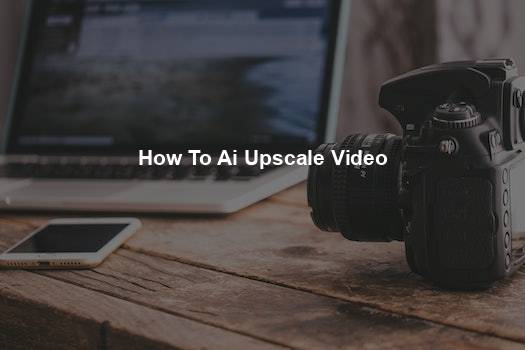In today’s digital age, videos have become an integral part of our lives, from capturing precious memories to sharing captivating stories. However, as technology advances, the quality of videos we capture may not always meet our expectations. That’s where the revolutionary concept of AI upscaling comes into play. By harnessing the power of artificial intelligence, we can enhance the resolution and overall visual experience of our videos, bringing them to a whole new level.
AI upscaling, also known as video enhancing, is a cutting-edge technique that utilizes machine learning algorithms to upscale low-resolution videos to higher resolutions. This groundbreaking technology analyzes the content of each frame, identifies patterns, and extrapolates missing details, resulting in a significantly improved visual quality. Whether you’re a professional filmmaker looking to enhance the aesthetics of your footage or an enthusiast seeking to revamp home videos, AI upscaling offers an incredible opportunity to elevate the visual appeal of your videos in a simple and efficient manner. Join me as we delve into the world of AI upscaling and explore the tools, techniques, and benefits of this remarkable technology.
- Download and install an AI-powered video upscaling software like Topaz Video Enhance AI.
- Launch the software and import the video you want to upscale.
- Select the desired settings, such as output resolution and enhancement options.
- Click on the “Start” button to begin the AI upscaling process.
- Once the process is complete, save the upscaled video to your preferred location.
How to AI Upscale Video
Welcome to this step-by-step guide on how to use AI to upscale your videos. If you want to enhance the quality and resolution of your video footage, artificial intelligence can be a powerful tool. By following these instructions, you’ll be able to take advantage of AI technology to improve your videos and create stunning visual content. Let’s dive in!
Step 1: Choose the Right AI Upscaling Software
The first step in the process is to select the appropriate AI upscaling software. There are several options available, each with its own set of features and capabilities. Take the time to research and compare different software to find the one that best suits your needs and budget. Look for software that offers an easy-to-use interface, high-quality upscaling algorithms, and compatibility with your video editing software. Once you’ve made your choice, download and install the software on your computer.
Step 2: Prepare Your Video Files
Before you can start the AI upscaling process, you need to prepare your video files. Make sure they are in a format supported by the AI upscaling software you’ve chosen. If not, convert them to a compatible format using a video converter tool. It’s also a good idea to create a backup of your original video files in case anything goes wrong during the upscaling process. Once your files are ready, open the AI upscaling software and import the videos you want to enhance.
Step 3: Configure the AI Upscaling Settings
Once your video files are loaded into the AI upscaling software, it’s time to configure the settings. Depending on the software you’re using, you may have options to adjust parameters such as resolution, sharpness, noise reduction, and color correction. Experiment with these settings to achieve the desired result. Keep in mind that upscaling can introduce artifacts or distortions, so it’s important to strike a balance between enhancing the video quality and maintaining its original integrity.
Step 4: Start the AI Upscaling Process
After configuring the settings, you’re ready to start the AI upscaling process. Click on the “Upscale” or “Enhance” button in the software to begin. The software will analyze your video frames and apply its AI algorithms to enhance the resolution and overall quality. Depending on the length and complexity of your video, this process may take some time. Be patient and let the software do its job. It’s a good idea to save your progress regularly to avoid losing any changes.
Step 5: Review and Export the Upscaled Video
Once the AI upscaling process is complete, it’s time to review the results. Play the upscaled video in the software’s preview window to see the improvements. If you’re satisfied with the outcome, you can export the video in the desired format and resolution. Make sure to choose a high-quality output format to preserve the enhanced details. Give your upscaled video a proper filename and save it to your preferred location on your computer or external storage device.
Step 6: Further Editing and Enhancement (Optional)
If you want to take your upscaled video to the next level, you can consider further editing and enhancement. Import the upscaled video into your preferred video editing software and apply additional effects, color grading, or audio enhancements. This step is optional but can add a professional touch to your final video. Remember to save your edited video as a new file to avoid overwriting the original upscaled version.
Step 7: Share and Enjoy
Now that you have successfully upscaled your video using AI technology, it’s time to share and enjoy your creation. Whether you’re uploading it to social media, showcasing it on your website, or using it for personal projects, be proud of the improved video quality you’ve achieved. Share your upscaled videos with others and gather feedback to continue improving your skills in AI video upscaling.
Frequently Asked Questions
Here are some frequently asked questions about how to AI upscale video:
What is AI upscaling for videos?
AI upscaling for videos is a technique that uses artificial intelligence algorithms to enhance the quality of low-resolution videos. It analyzes the content of the video and applies advanced algorithms to fill in missing details, improve sharpness, and enhance overall visual quality. This process can help make videos look crisper and more detailed, even when starting with lower-quality source footage.
How does AI upscaling work?
AI upscaling works by training neural networks on a large dataset of high-resolution videos. These networks learn to analyze and understand the patterns and structures in videos, allowing them to predict and generate missing details in low-resolution videos. By using the knowledge gained from the training data, the AI algorithms can then upscale lower-resolution videos, improving their visual quality.
What are the benefits of AI upscaling for videos?
AI upscaling for videos offers several benefits. First, it can help improve the visual quality of low-resolution videos, making them more enjoyable to watch. It can also be useful for enhancing older or vintage videos, bringing them closer to modern standards. Additionally, AI upscaling can be valuable for professional purposes, such as video restoration or improving the quality of surveillance footage.
However, it’s important to note that AI upscaling is not a magical solution and may not always produce perfect results. The effectiveness of the upscaling process depends on various factors, including the quality of the source video and the capabilities of the AI algorithms being used.
What software or tools can be used for AI upscaling?
There are several software and tools available for AI upscaling of videos. Some popular options include Topaz Video Enhance AI, Gigapixel AI, and DAIN-App. These tools utilize advanced AI algorithms and provide user-friendly interfaces to upscale videos effectively. It’s important to choose a tool that best fits your specific requirements and budget, as different options may have varying features and capabilities.
Are there any limitations or considerations when using AI upscaling for videos?
While AI upscaling can significantly improve the visual quality of videos, there are some limitations and considerations to keep in mind. First, the quality of the final upscaled video depends on the quality of the source video. If the source video is extremely low resolution or has significant artifacts, the upscaling process may not be able to produce satisfactory results.
Additionally, AI upscaling can be computationally intensive and may require powerful hardware to run efficiently. It’s also important to consider the legal aspects of upscaling videos, especially when it comes to copyright and intellectual property rights. Finally, it’s always recommended to experiment with different settings and techniques to achieve the desired results when using AI upscaling tools.
In conclusion, the process of AI upscaling video has revolutionized the world of video editing and production. With its ability to enhance the quality and resolution of footage, it offers endless possibilities for content creators, filmmakers, and even casual video enthusiasts. By harnessing the power of artificial intelligence, individuals can now transform low-resolution videos into stunning high-definition masterpieces.
As we continue to advance in technology, AI upscaling video is poised to become an indispensable tool in the realm of video editing. Its ability to not only enhance the visual quality but also preserve the original content’s essence makes it a game-changer in the industry. Whether it’s restoring old footage, improving the clarity of low-resolution videos, or simply adding a touch of professionalism to your content, AI upscaling video is a powerful tool that opens up new horizons for creators. So, embrace the AI revolution and take your videos to the next level with this groundbreaking technology.













